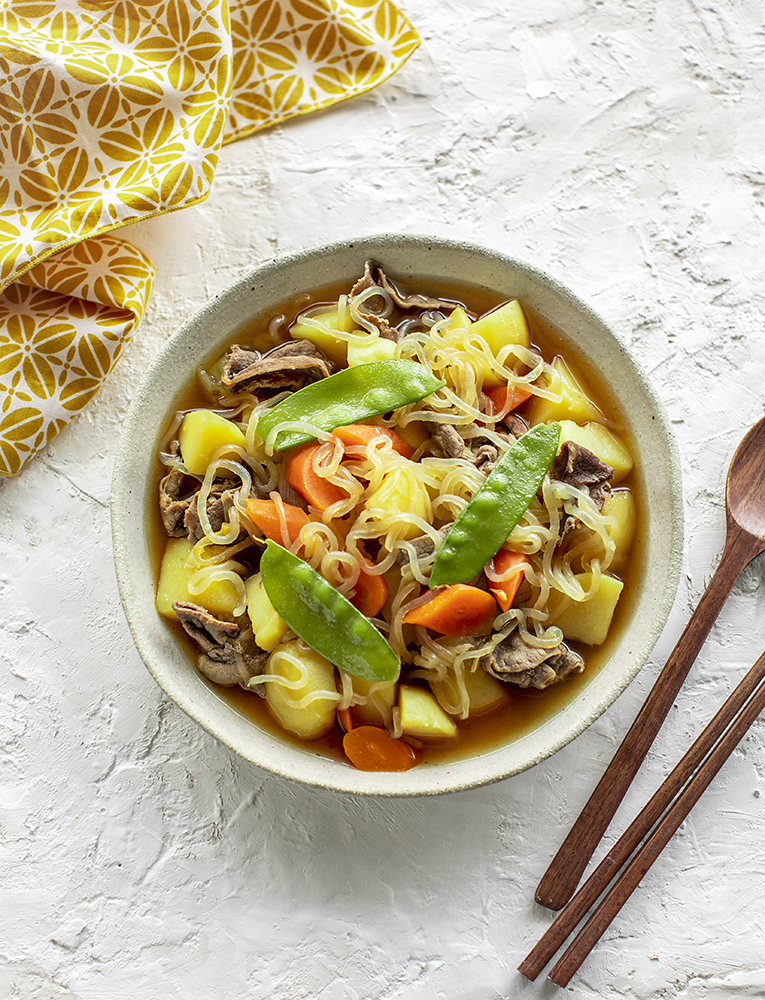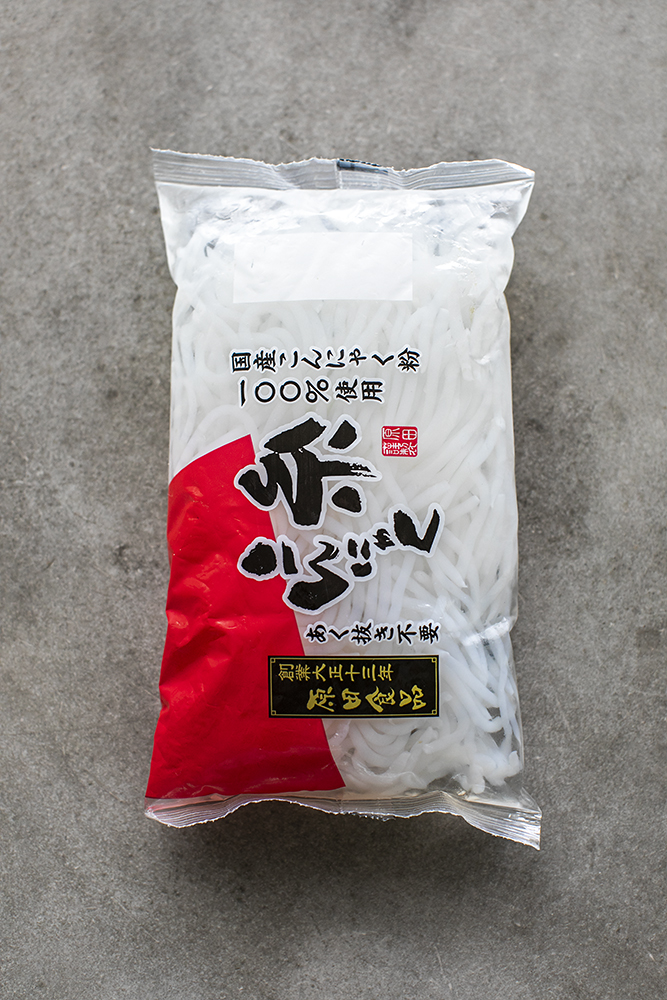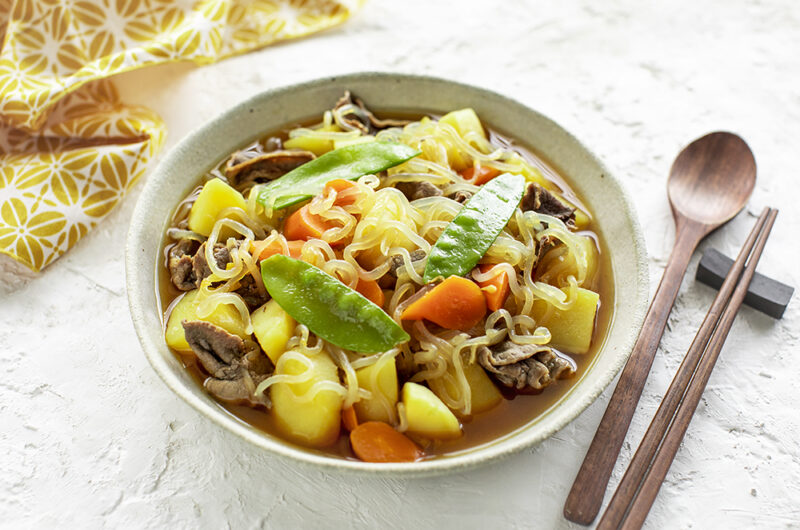
Nikujaga is a typical home-cooked winter dish that Japanese moms and grandmas cook for their children. And it feels definitely like a mom’s hug. And will make your winter comfortable and warm.
Nikujaga (lit. ‘meat [and] potatoes’) is a typical yōshoku dishes, Western-influenced cooking which originated during the Meiji Restoration. Before we start, you may need to learn some details about ingredients and techniques.
Shabu shabu style beef is thinly sliced beef. You can also find shabu shabu pork or lamb, that can be used in other dishes. This cut of meat is used for Shabu Shabu, hot pot dishes, Gyudon, and Yakiniku. Shabu shabu usualy is cut of high quality meat, and it cooks quickly.
It can be challenging to cut meat shabu shabu style at home. I usually buy it from Asian butcher shop. This time I found a very tasty shabu shabu beef in my regular supermarket. Holly macaroni, I really love Auckland for this! If you like Asian food, it’s priceless to get all your favourite Asian food in nearest supermarket!
How to cut vegetables. In Japanese cuisine cutting of vegetables and the shapes of chunks is a very important. You have to choose the best suitable cutting technique for the dish you cook, to get the best texture and taste as a result. It also should be suitable for eating by chopsticks. Onion that is cut into half moon slices has an absolutely amazing texture in this quick stew. Rangiri is a way of cutting cylindrical vegetables such as carrots, and consists of random, diagonal cuts made while rotating the vegetable one-quarter turn between cuts. The large, evenly cut surfaces allow for absorption of flavor, making this method particularly suitable when simmering. To cut the potato into rangiri slices, cut it into long pieces first.
Cartouche. In culinary terms, a cartouche is a round piece of parchment or grease-proof paper that covers the surface of a stew, soup, stock or sauce to reduce evaporation, to prevent a skin from forming and/or to keep components submerged. Cartouche can help to reduce the cooking time of Nikujaga. It will stop the vegetables from moving and prevent falling apart. I also recommend do not skip the step with skimming the foam, it will directly affect on how the dish will look.
Shirataki noodles (on the photo below), also known as konjac noodles, or miracle noodles, are a unique food that’s very filling yet low in calories, only 5 calories per 100 gram. These Japanese noodles are made using konjac yam and water. Shirataki are really high in fibre, soy free, low carb, gluten free and pretty much calorie free. You can find this type of noodles in Asian supermarkets.

Nikujaga (Japanese meat and potato stew)
Course: Japanese Food, MeatDifficulty: Medium3-4
servings10
minutes20
minutesIngredients
200g shabu shabu style beef, room temperature (thawed if frozen)
1 brown onion, sliced (half moon slices)
1 long carrot, peeled, cut using rangiri cutting technique
3 large Agria potatoes, peeled, cut using rangiri cutting technique
1 package shirataki noodles (200g)
10 snow peas, string removed
3 cups dashi stock (or 3 cups water and instant dashi powder)
1/4 cup sake
1/4 cup mirin
1/4 cup + 1 Tbs light coloured soy sauce (or regular soy sauce)
1 Tbs coconut sugar
1-2 Tbs golden sugar
cooking oil
Directions
- Wash the shirataki noodles thoroughly to remove the fishy taste. Then bring sauce pan with water to a boil and cook the shirataki for one minute. Drain well, cut the shirataki using kitchen scissors into shorter noodles. Set aside.
- Preheat a Dutch oven on a meduim heat. Add one tablespoon of cooking oil (canola oil works great) and onion. Cook for about 4-5 minutes. Add the shabu shabu style meat. Cook for another 4 minutes. Add the carrot and potato. Cook for about 4 minutes.
Add the prepared shirataki noodles, dashi stock, sake, mirin, soy sauce and sugar. Makes sure the vegetables and meat are covered by liquid. Bring to a boil and skim all the foam from a surface using a fine mesh skimmer. Place a cartouche on a surface of the stew, then place tight fitting lid. Switch the heat to a medium low and cook for about 15 – 20 minutes or until the potato is tender and liquid is reduced. - Taste the dish, add more sugar or soy sauce if needed. Place the snow peas on top. Cook for about 5 minutes or until the snow peas is cooked but still a bright green. You can also cook the snow peas separately to prevent overcooking.
- Let the stew to chill slightly, if it’s served warm, the taste is much better. Divide the stew among bowls. Place the snow peas on a top. Serve with a steamed rice. Enjoy!
Notes
- If you have leftovers, just turn it in Japanese stew for a next dinner, adding more dashi and Japanese curry cubes (you can find it in a supermarket).

